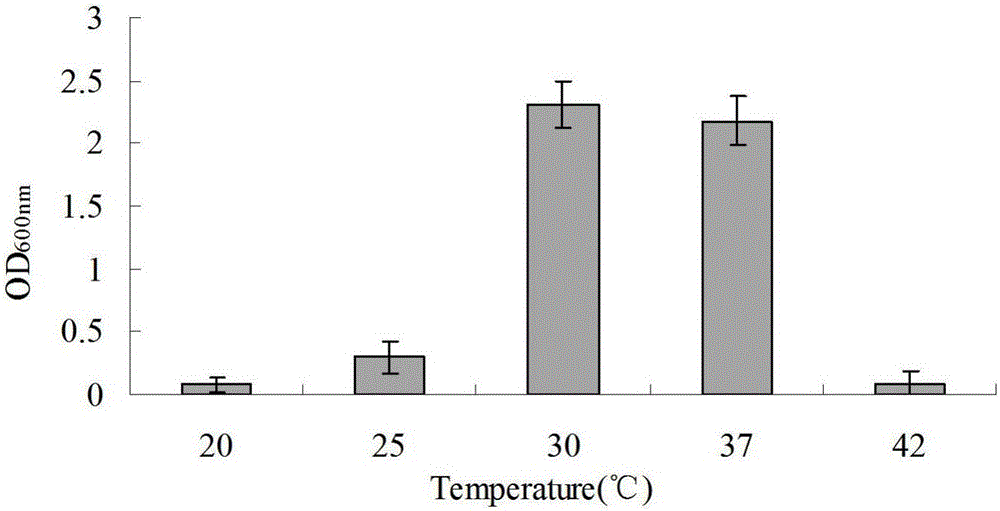Strain for degrading phenol compounds and application of strain
A technology for phenolic compounds and strains, applied in the field of strains that efficiently degrade phenolic compounds, can solve the problems of high toxicity and less degradation of phenol derivatives, and achieve the effect of enriching diversity
- Summary
- Abstract
- Description
- Claims
- Application Information
AI Technical Summary
Problems solved by technology
Method used
Image
Examples
Embodiment 1
[0045] Isolation and screening of phenol-degrading strain Sphingomonas paucimobilis DL-10:
[0046] Take 5mL sample of industrial wastewater containing phenol and place it in 100mL inorganic salt culture medium containing 50mg / L phenol, at 30℃, 180r·min -1 Cultivate for 2-3d. Use an ultraviolet scanner to measure the degradation of phenol in the enriched solution. After confirming that the phenol is degraded, insert 10% of the inoculum into the medium containing 75mg / L phenol inorganic salt, continue to enrich and determine the degradation, click here Method until the phenol concentration is increased to 200mg / L, and passage 3 times.
[0047] The phenol enrichment solution was gradually diluted and spread on an inorganic salt medium plate with 100mg / L phenol as the sole carbon source, and cultured in an incubator at 30°C for 2-3 days. The single colonies with different colonies grown on the plate were streaked on a 1 / 3LB plate for purification, and inoculated in an inorganic salt ...
Embodiment 2
[0052] Identification of phenol-degrading strain Sphingomonas paucimobilis DL-10 and its growth characteristics:
[0053] Identification of DL-10:
[0054] Perform 16S rDNA identification on DL-10: use primer 27F: 5`-AGAGTTTGATCCTGGCTCAG-3` and 1492R: 5`-TACCTTGTTACGACTT-3` to amplify the 16S rDNA of strain DL-10, and connect to the clone by T / A cloning Vector pMD19T, construct recombinant cloning vector pMD19T-16S, transform it into the cloning host Escherichcoli DH5α to obtain recombinant microorganism Escherich coli DH5α (pMD19T-16S), sequence the obtained recombinant microorganism foreign fragments, NCBI database compares the 16S rDNA sequence, the strain DL-10 was identified to Sphingomonas at the molecular level, and the nucleotide sequence of its 16S rDNA is shown in SEQ ID NO:1 in the sequence table.
[0055] Growth characteristics of DL-10:
[0056] Sphingomonas paucimobilis DL-10 grows slowly on LB plates. It can form yellow colonies with a diameter of 2mm at 30°C for 96 ho...
Embodiment 3
[0059] Degradation characteristics of phenol degrading bacteria Sphingomonas paucimobilis DL-10:
[0060] Pick single colonies of strain DL-10 from the 1 / 3LB plate and inoculate them in 3mL 1 / 3LB liquid medium at 30℃, shaker 180r·min -1 Cultivate for 48h. Then the culture solution of the strain was transferred to 20 mL of fresh liquid 1 / 3 LB medium, and the culture was continued for 18 h. 6000r·min -1 Centrifuge for 10 min, collect the bacteria, wash once with sterilized inorganic salt medium, and make OD 600nm = 1.0 bacterial suspension, namely seed liquid.
[0061] In an inorganic salt medium with a final concentration of phenol of 100 mg / L, insert OD at 5% inoculum 600nm =1.0 strain DL-10 seed liquid, at 30℃, 180r·min -1 Shake culture, take samples every 2h, measure OD 600nm And the concentration of phenol.
[0062] by Figure 4 It can be seen that the strain DL-10 was inoculated into the culture medium for 2 hours, and then it began to degrade phenol without obvious delay; after...
PUM
| Property | Measurement | Unit |
|---|---|---|
| Diameter | aaaaa | aaaaa |
Abstract
Description
Claims
Application Information
 Login to View More
Login to View More - R&D
- Intellectual Property
- Life Sciences
- Materials
- Tech Scout
- Unparalleled Data Quality
- Higher Quality Content
- 60% Fewer Hallucinations
Browse by: Latest US Patents, China's latest patents, Technical Efficacy Thesaurus, Application Domain, Technology Topic, Popular Technical Reports.
© 2025 PatSnap. All rights reserved.Legal|Privacy policy|Modern Slavery Act Transparency Statement|Sitemap|About US| Contact US: help@patsnap.com



